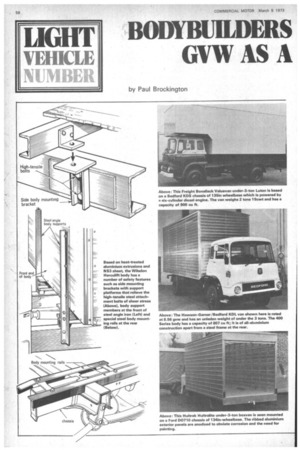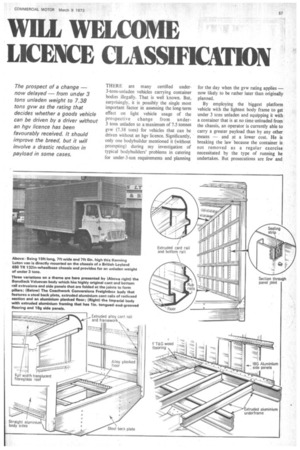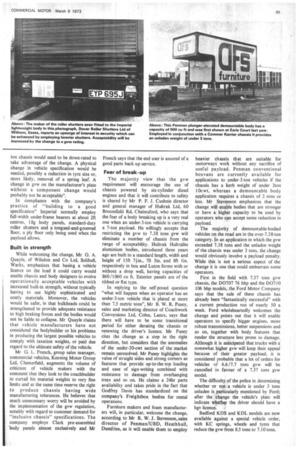BODYBUILDERS WILL WELCOME GVW AS A LICENCE CLASSIFICATION
Page 58

Page 59

Page 60

Page 61

If you've noticed an error in this article please click here to report it so we can fix it.
The prospect of a change — now delayed — from under 3 tons unladen weight to 7.38 tons gvw as the rating that decides whether a goods vehicle can be driven by a driver without an hgv licence has been favourably received. It should improve the breed, but it will involve a drastic reduction in payload in some cases. THERE are many certified under3-tons-unladen vehicles carrying container bodies illegally. That is well known. But, surprisingly, it is possibly the single most important factor in assessing the long-term effect on light vehicle usage of the prospective change from under3 tons unladen to a maximum of 7.5 tonnes gvw (7.38 tons) for vehicles that can be driven without an hgv licence. Significantly, only one bodybuilder mentioned it (without prompting) during my investigation of typical bodybuilders' problems in catering for under-3-ton requirements and planning for the day when the gvw rating applies — now likely to be rather later than originally planned.
By employing the biggest platform vehicle with the lightest body frame to get under 3 tons unladen and equipping it with a container that is at no time unloaded from the chassis, an operator is currently able to carry a greater payload than by any other means —• and at a lower cost. He is breaking the law because the container is not removed as a regular exercise necessitated by the type of running he undertakes. But prosecutions are few and far between and many operators obviously consider them worth risking. The change to a gvw rating will eliminate the advantage of this practice; in fact the additional weight of a platform /container vehicle compared with a direct-mounted van will give the latter a useful payload advantage.
Most types of body can be built as a container for the purpose mentioned. And some bodybuilders shrug off the prospect of building more bodies and less containers for light vehicles, although they welcome the change for other reasons. Others consider that the demise of the platform/container vehicle in this category will enhance the scope for improvements that the gvw regulation will provide.
Greater latitude
All the bodybuilders contacted.during an investigation of problems created by under-3-ton-unladen requirements and the prospect of the change to the gvw rating of 7.38 tons welcomed the change (some with reservations) on the score of greater latitude in equipping the body, in the choice of a suitable chassis and in catering for overweight chassis. The reservations could, however, have serious implications.
While an operator carrying bulky loads will readily accept a lower nominal payload in exchange for greater latitude in the specification of the body and chassis, the operator whose profitability depends on carrying the maximum possible payload will be heavily penalized by the change in some cases. The example is given by Mr M. P. R. Fraser, retail sales manager of Hawson-Garner Ltd, of Sunburyon-Thames, Middx, of a Bedford KDL chassis of 151in. wheelbase with an 8.56 tons gvw that is equipped with a Hawson-Garner 16ft lightweight body and has an unladen weight of under 3 tons, the payload being 5+ tons. Operators of such vehicles will, according to Mr Fraser, be looking for the absolute maximum in payload, which typically will be around 4+ tons.
Mr Fraser told me that the Hawson-Garner range of 400 Series 1411 and 1611 aluminium bodies with steel rear-aperture frames is designed to get as near as possible to the current demand for a payload of 5 tons. He forecasts that many operators carrying heavy loads may well favour employing a larger number of 7.38-ton-gvw chassis with the shortest wheelbase that is currently available, in preference to a smaller number of larger vehicles requiring hgv licensed drivers.
Guarding against damage
Operators in this category could well include those carrying paper, machinery, drums of liquid, and so on. There is, he said, a proven demand for heavier steel-panelled boxvans by operators such as wholesale vegetable growers, whose vehicles regularly travel along narrow lanes with overhanging trees, frequently operate off the road and are equipped with mechanical loading devices and to whom resistance to damage is a priority consideration.
There could be a demand for a new breed of chassis suitable for easy-access vehicles, in Mr Fraser's opinion, if there is a swing towards the use of heavier vehicles (in the lightweight category) for general haulage. This could bring the easy-access van back into vogue, although it is unlikely that current styles will be retained. But while bodywork styles will change, the demand will continue for a large capacity and a payload of 2/3 tons.
Two stories (relating to other companies!) are told by Freight Bonallack Ltd, Basildon, Essex, that illustrate the touch-and-go aspect of getting below an unladen weight of 3 tons. In one case a chassis was so close to the manufacturer's limit that a coat of paint on the frame members increased the weight of the bodied vehicle to over 3 tons. And in the other the ply lining of the chequer-plate floor had to be removed to reduce the weight of an insulated vehicle to under 3 tons, with the result that the floor "gave a good imitation of a trampoline".
A Bonallack technician summed up the effect of prospective gvw limit for hgv licences: "At present the regulations put the onus on the bodybuilder, not the operator. In future the bodybulder will have greater freedom while the operator will be able to specify exactly what he wants while still having an acceptable payload".
And in the opinion of Chris Oxborrow, general sales manager of the Norwich division: "While it is extremely difficult currently to build an efficiently insulated body to a 3-tons-unladen limit without sacrificing something in the way, of equipment or strength, there will be every opportunity to build a properly insulated fully equipped van that can carry an adequate payload when the limit is changed. We are adapting our present light refrigerated design to take full advantage of the new regulations, but it is difficult at present to meet the two limits at the same time. The wider choice of options applicable to all types of light body could, for example, include a lined interior, side door or even a tail-lift."
Mr A. C. Bull, sales manager of Imperial Coachbuilders (Basildon) Ltd, Basildon, appears to be in a minority in his argument that the introduction of under-30-cwt and under-3-ton vehicle categories was a challenge to bodybuilders that paid off in terms of improved structural techniques. But he points out that bodies having wide-spaced bearers, light-gauge ply floors and 20 swg panels designed for vehicles of 3 tons payload capacity are frequently fitted to under-3-tons-unladen vehicles and emphasizes that the serviceability of such vehicles has yet to be proved in many cases.
Retrospective legislation?
Particular mention is made by Mr Bull of the recently issued code of practice, Safety of Loads on Vehicles, and he cites the fitting of cargo retention devices as an option that is in line with this code; but it is one which is often omitted in under-3-ton vehicles because of the weight paring necessity. "When this change to gvw is introduced", he said, "it could be retrospective. Vehicles such as the Bedford KD 8.5-ton, Commer VC 441 7.9-ton, Terrier 750 7.5-ton and Ford D0807 7.7
ton chassis would need to be down-rated to take advantage of the change. A physical change in vehicle specification would be needed, possibly a reduction in tyre size or, more likely, removal of a spring leaf. A change in gvw on the manufacturer's plate without a component change would probably not be acceptable".
In compliance with the company's practice of "building to a good specification" Imperial normally employ full-width under-frame bearers at about 211 centres, 18g body panels, standard-duty roller shutters and a tongued-and-grooved 'floor, a ply floor only being used when the payload allows.
Built in strength While welcoming the change, Mr G. A. Quayle, of Wilsdon and Co Ltd, Solihull, Warks, emphasizes that basing a vehicle licence on the load it could carry would enable chassis and body designers to evolve operationally acceptable vehicles with increased built-in strength, without typically having to use highly sophisticated and costly materials. Moreover, the vehicles would be safer, in that bulkheads could be strengthened to provide adequate resistance to high braking forces and the bodies would not be liable to collapse. Mr Quayle claims that vehicle manufacturers have not considered the bodybuilder or his problems in producing the largest possible vehicles to comply with taxation weights, or paid due regard to the ultimate safety of the vehicle.
Mr G. L, French, group sales manager, commercial vehicles, Kenning Motor Group Ltd, Chesterfield, augments the volume of criticism of vehicle makers with the comment that they look to the coachbuilder to curtail his material weights to very fine limits and at the same time reserve the right to produce chassis having wide manufacturing tolerances. He believes that much unnecessary worry will be avoided by the implementation of the gvw regulation, notably with regard to customer demand for "inclusive chassis" specifications. The company employs Clark pre-assembled body panels almost exclusively and Mr French says that the end user is assured of a good parts back-up service.
Fear of break-up
The majority view that the gvw requirement will encourage the use of chassis powered by six-cylinder diesel engines and that it will contribute to safety is shared by Mr P. F. J. Cushnie director and general manager of Hultrak Ltd, 60 Broomfield Rd, Chelmsford, who says that the fear of a body breaking up is a very real one when an under-3-ton vehicle is carrying a 74on payload. He willingly accepts that restricting the gvw to 7.38 tons gvw will eliminate a number of chassis from the range of acceptability. Hultrak Hultralite aluminium bodies, introduced three years ago are built to a standard length, width and height of 1511 nin., 711 3M. and 8ft lin. respectively in box and Luton forms with or without a drop well, having capacities of 860/1060 Cu ft. Exterior panels are of the ribbed or flat type.
In replying to the self-posed question "what will happen when an operator has an under-3-ton vehicle that is plated at more than 7.5 metric tons", Mr B. W. R. Pusey, sales and marketing director of Coachwork Conversions Ltd, Colne, Lanes, says that there will have to be some transitional period for either derating the chassis or renewing the driver's licence. Mr Pusey cites the change as a step in the right direction, but considers that the anomalies of the under-30-cwt section of the market remain unresolved. Mr Pusey highlights the value of straight sides and strong corners as features that provide up-to-the-top loading and ease of sign-writing combined with resistance to damage from overhanging trees and so on. He claims a 24hr parts availability and takes pride in the fact that Godfrey Davis has standardized on the company's Freightbox bodies for rental operations Furniture makers and foam manufacturers will, in particular, welcome the change, according to Mr R. W. J. Stevenson, sales director of Penman/UBD, Heathhall, Dumfries, as it will enable them to employ heavier chassis that are suitable for motorways work without any sacrifice of useful payload. Penman conventional boxvans are currently available for applications to under-3-ton vehicles if the chassis has a kerb weight of under 2ton lOcwt, whereas a demountable body application requires a chassis of 2 tons or less. Mr Stevenson emphasizes that the change will enable bodies that are stronger or have a higher capacity to be used by operators who can accept some reduction in payload.
The majority of demountable-bodied vehicles on the road are in the over-7.38-ton category. In an application in which the gvw exceeded 7.38 tons and the unladen weight of the chassis was under 3 tons, the change would obviously involve a payload penalty. While this is not a serious aspect of the change it is one that could embarrass some operators.
First in the field with 7.37 tons gvw chassis, the D0707 76 bhp and the D0710 106 bhp models, the Ford Motor Company says that the sale of these chassis has already been "fantastically successful" with a current production run of nearly 50 a week. Ford wholeheartedly welcomes the change and points out that it will enable operators to specify bigger engines, more robust transmissions, better suspensions and so on, together with body features that render the structure less prone to damage. Although it is anticipated that trucks with a somewhat higher gvw will keep their appeal because of their greater payload, it is considered probable that a lot of orders for vehicles of 6.6/7.7 tons gvw will be cancelled in favour of a 7.37 tons gvw model.
The difficulty of the police in determining whether or not a vehicle is under 3 tons unladen is particularly mentioned by Ford; after the change the vehicle's plate will indicate Whether the driver should have a hgv licence.
Bedford KDS and KDL models are now available against a special vehicle order, with KC springs, wheels and tyres that reduce the gvw from 8.5 tons to 7.10 tons.




















































































































































